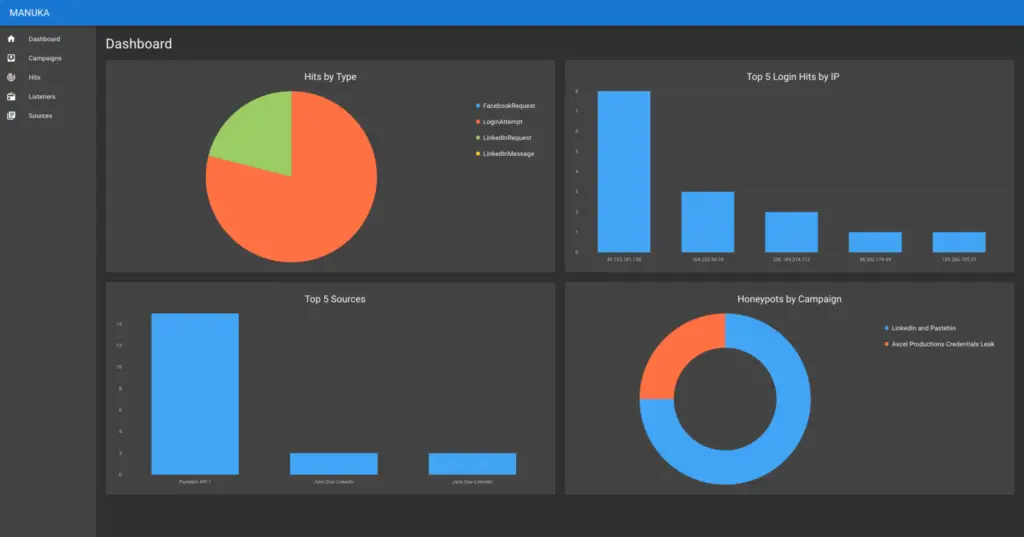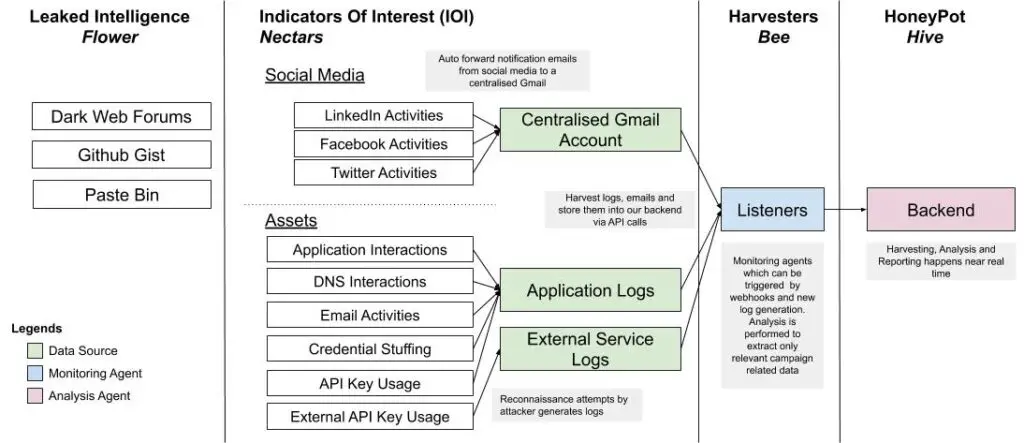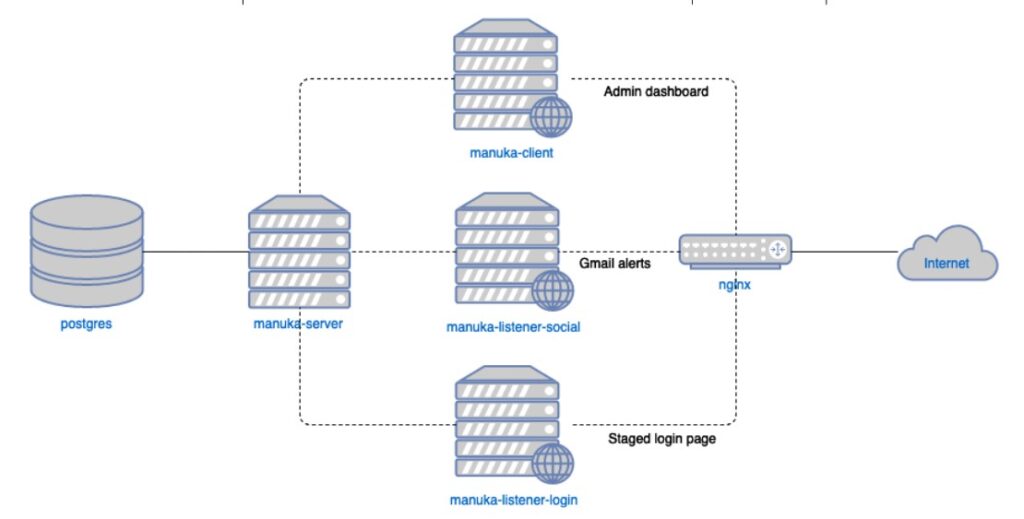
Manuka – A Modular OSINT Honeypot For Blue Teamers

Manuka is an Open-source intelligence (OSINT) honeypot that monitors reconnaissance attempts by threat actors and generates actionable intelligence for Blue Teamers. It creates a simulated environment consisting of staged OSINT sources, such as social media profiles and leaked credentials, and tracks signs of adversary interest, closely aligning to MITRE’s PRE-ATT&CK framework. Manuka gives Blue Teams additional visibility of the pre-attack reconnaissance phase and generates early-warning signals for defenders.
Although they vary in scale and sophistication, most traditional honeypots focus on networks. These honeypots uncover attackers at Stage 2 (Weaponization) to 7 (Actions on Objectives) of the cyber kill chain, with the assumption that attackers are already probing the network.

Manuka conducts OSINT threat detection at Stage 1 (Reconnaissance) of the cyber kill chain. Despite investing millions of dollars into network defenses, organisations can be easily compromised through a single Google search. One recent example is hackers exposing corporate meetings, therapy sessions, and college classes through Zoom calls left on the open Web. Enterprises need to detect these OSINT threats on their perimeter but lack the tools to do so.
Manuka is built to scale. Users can easily add new listener modules and plug them into the Dockerized environment. They can coordinate multiple campaigns and honeypots simultaneously to broaden the honeypot surface. Furthermore, users can quickly customize and deploy Manuka to match different use cases. Manuka’s data is designed to be easily ported to other third-party analysis and visualization tools in an organisation’s workflow.
Designing an OSINT honeypot presents a novel challenge due to the complexity and wide range of OSINT techniques. However, such a tool would allow Blue Teamers to “shift left” in their cyber threat intelligence strategy.
Dashboard

Tool Design
Architecture
Manuka is built on the following key terms and processes.

- Sources: Possible OSINT vectors such as social media profiles, exposed credentials, and leaked source code.
- Listeners: Servers that monitor sources for interactions with attackers.
- Hits: Indicators of interest such as attempted logins with leaked credentials and connections on social media.
- Honeypots: Groups of sources and listeners that are organized into a single Campaign that analyzes and tracks hits over time.

The framework itself consists of several Docker containers that can be deployed on a single host.
- manuka-server: Central Golang server that performs CRUD operations and ingests hits from listeners.
- manuka-listener: Modular Golang server that can perform different listener roles.
- manuka-client: React dashboard for Blue Team to manage Manuka’s resources.
These containers are orchestrated through a single docker-compose command.
Development
In development, the components run on the following ports in their respective containers:
manuka-client:3000manuka-server:8080manuka-listener:8080
To allow for the client and server to talk without CORS issues, an additional nginx layer on localhost:8080 proxy-passes /api/ to manuka-server amd / to manuka-listener.
In addition, manuka-listener operates on the following ports:
8081for the staged login webpage8082for interacting with the staged email
Requirements
See the individual component repositories for their requirements.
docker >= 19.03.8docker-compose >= 1.25.4ngok >= 2.3.35
Configure
- Create a file in
docker/secrets/postgres_passwordwith the password for Postgres. - Setup Google accounts for Gmail to receive emails from social media profiles.
- Setup Google Cloud Pub/Sub on https://console.cloud.google.com/cloudpubsub for push email functionality (guide: https://developers.google.com/gmail/api/guides/push). The guide will have instructions to create a Cloud project too.
- Create file
docker/secrets/google_credentials.jsonwith your project’s credentials. - Add the topic created on Cloud Pub/Sub to
docker/secrets/google_topic. - Obtain an oauth2 token for your Google account. Manuka requires an oauth2 token the first time it is run. Subsequently, it will automatically refresh the token. Save the token in
docker/secrets/google_oauth2_token.json.
Run
docker-compose -f docker-compose.yml -f docker-compose-dev.yml up --build --remove-orphans- Initialize
manuka-listenergmail push service:- Initialize ngok
./ngok http <manuka-listener port>and take note of the https URL. - On Google PubSub dashboard left-hand menu, go to Subscriptions -> <subscription name> -> Edit Subscription and change the Endpoint URL to <ngok https URL>/notifications.
- Try sending an email from another account to the target Gmail account. You should see
POST /notifications 200 OKon thengrokconsole, andReceived push notificationon the Docker console.
- Initialize ngok
Production
In production, the following ports map to these servers:
8080:manuka-clientat/andmanuka-serverat/api80:manuka-listener-loginat/andmanuka-listener-socialat/notifications
This allows any domain that points to your server to appear as the fake login page, while the administration dashboard is available at port 8080. Furthermore, the administration dashboard is protected by HTTP basic authentication at the nginx layer.
Requirements
See the individual component repositories for their requirements.
docker >= 19.03.8docker-compose >= 1.25.4ngok >= 2.3.35
Configure
- Similar to the configuration for development, ensure that all secrets and Google Cloud settings are in place. Note that the subscription URL should now be at
http://DOMAIN/notifications. - Point your domain name to your server IP.
- Copy
docker/nginx/nginx.prod.conf.exampletodocker/nginx/nginx.prod.confand replaceexamplecompany.comwith your production domain. - Run
init-letsencrypt.shto generate your SSL certificates.
Run
COMPANY_NAME='Next Clarity Financial' NGINX_USERNAME=username NGINX_PASSWORD=password docker-compose -f docker-compose.yml -f docker-compose-prod.yml up --build --remove-orphans -dNGINX_USERNAMEandNGINX_PASSWORDwill be your dashboard basic authentication.COMPANY_NAMEwill be the fake login page company name.
Currently Supported Listeners
- Social ListenerMonitors for social activities on Facebook and LinkedIn. Currently supports notification of network connection attempts. Note that the monitored social media account(s) should have email notification enabled. The corresponding email account(s) receiving the email notifications from the social media platforms should be configured to forward these emails to the centralised gmail account.
- Login ListenerMonitors for attempted login using leaked credentials on the honeypot site.
Acknowledgment
- Eugene Lim
- Bernard Lim
- Kenneth Tan
- Tan Kee Hock
























Leave a Reply